March/April 2023
Managing Gill’s mealybug in pistachio
Close monitoring and smart rotations are key
Gill’s mealybug is a persistent pest of pistachios, not. The grape mealybug does not require treatment, so feeding on nut clusters and leaving behind a mess in the form of honeydew, affecting nut marketability. The honeydew serves as a substrate for black sooty molds that stain the hulls, but not the shells underneath.
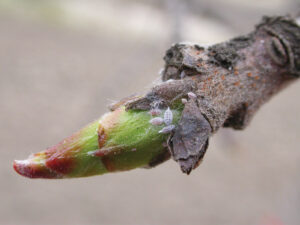
Because the insects suck up sugars that would otherwise enhance nut growth, the nuts may be smaller and less likely to split when they should. These mealybugs mainly attack the nut hulls, so they’re not found on pre-bearing or male trees. Young California pistachio orchards thus go through a period where they are not infested. The mealybugs eventually appear and build up over time, but typically they can be maintained at a low level with good management.
In California, winter monitoring for Gill’s mealybug would reveal dead adult females on the trunks and branches. The females possess two wide tails, distinguishing them from grape mealybugs, which feature four slender tails, two short and two long. Also, when poked, grape mealybugs exude a red liquid, but Gill’s mealybug does it is important to determine the species as part of the pest management program.
Thought to originate in the Southeastern U.S., Gill’s mealybug so far has not been reported in Arizona or New Mexico. Since the females do not fly, and California harvesting equipment is not typically transported to those states, hopefully the mealybugs will not hitch a ride to the pistachio orchards there.
Spots of heavy infestation of the dead mealybug adults in the winter can be flagged for careful checking in the spring. Early instar nymphs are also present in winter, but their tiny size and their behavior of hiding in cracks render them invisible in winter.
“You don’t care about (the dead mealybugs). What you care about is the babies that they made, that are teeny, tiny, first instars, tucked away in cracks and crevices, so you’re never going to find them,” said David Haviland, farm advisor, University of California Cooperative Extension, during a 2020 presentation. “I shouldn’t say, ‘never going to find them,’ because you are going to find them — around March.”
In March, the nymphs crawl to the buds, where they are visible on and near the new green tips. By late April, adult females make little “cotton candy” nests. By the third or fourth week of May or early June, females give live birth to crawlers. The crawlers appear as tiny, pale orange ovals congregated around and under the adult females in the nest and quickly move to feed on the hulls.
In most years, the crawlers’ birth is synchronized and quick, and crawlers lack the waxy coating that protects later instars from insecticides. Late May/early June is thus the “go time” point for treatment.
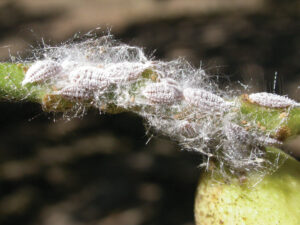
At later dates, the increased canopy and clusters further block the spray treatments. The May/June spray is called for economically if just one mealybug is found in every 10 clusters in May. If this May/ June treatment is missed, gobs of mealybugs may envelop the clusters later in the season.
TREATMENT OPTIONS
For treating mealybugs, the three best insecticides are spirotetramat (Movento, IRAC 24), acetamiprid (Assail, IRAC 4A) and buprofezin (Centaur, IRAC 16). If the May spray is missed, acetamiprid can be effective against second generation crawlers in mid- to late July. However, Gill’s mealybugs in the Hanford area of the San Joaquin Valley are showing some resistance to acetamiprid.
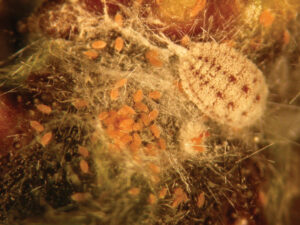
Buprofezin, in turn, should not be used later than March. The European Union (EU) rejects shipments with residues higher than the limit of 0.01 ppm for buprofezin. A good rotation to use all three products would be to apply spirotetramat in May/June of one year, followed by buprofezin in March and acetamiprid in May the next year.
Imidacloprid (Admire Pro, IRAC 4A) is less effective than the previous three insecticides, but its low cost (less than $10/acre) and ease of application through drip irrigation make it an acceptable choice with low mealybug populations. As with buprofezin, tolerances for residues are extremely low in the EU, so the Administrative Committee for Pistachios sets guidelines for its use. Growers can check with their processors on the current guidelines before applying imidacloprid.
A 2021 insecticide study found that additional products did well against Gill’s mealybug: spirotetramat and acetamiprid, as before, plus spirotetramat + pyrifoxen
PEST MANAGEMENT
(Senstar, IRAC 24 & 7C), sulfoxaflor (Sequoia, IRAC 4C), flupyradifurone (Sivanto, IRAC 4D) and phosmet (Imidan, IRAC 1B). Pistachios, however, have since been removed from the sulfoxaflor label due to higher-than-expected residues.
Further two-spray trials showed that Movento in May plus Assail or Sequoia in July both worked well. In addition, afidopyropen (Sefina, IRAC 9) did well at double the prescribed rate, so the manufacturer is investigating getting the double rate approved for pistachios.
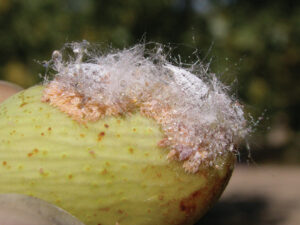
To prevent insect resistance, Haviland recommends rotating the insecticide from year to year, even if only one spray is used. For two sprays per year, the two should never be the same insecticide.
Postharvest treatment is not recommended for two reasons. First, it may kill beneficial predators at the time they are most active; second, spraying is not worth the cost because more than 99% of the nymphs die in the winter anyway.
CHALLENGES WITH RESISTANCE
Treatment for Gill’s mealybug has become more complicated in the past few years. Numerous observations indicate that insecticides are not working as effectively as when they were first registered in the mid-2000s. When first launched, one application of any of these products was adequate for season-long control. Now, in some cases, a follow-up spray in late July is needed to kill the second generation of crawlers.
The population skyrockets in early August if not treated, so the timing of that July spray is crucial.
“Once the nymphs are numerous and coated in wax, around Aug. 1, further spraying is useless,” Haviland said.
To ensure the spray is timely, the grower should monitor frequently for crawlers in late July and purchase product ahead of time.
BIOLOGICAL OPTIONS
Biological options are available for organic growers. Azadirachtin (Aza-Direct, a neem derivative) and Burkholderia spp. (Venerate, bacteria) applied in May, or azadirachtin in May and Burkholderia spp. applied in July, reduce the number of Gill’s mealybug by 60% to 80%.
Some growers also release predatory lacewings. Research on lacewings has not found conclusive evidence that they are cost-effective for managing Gill’s mealybugs in pistachios.
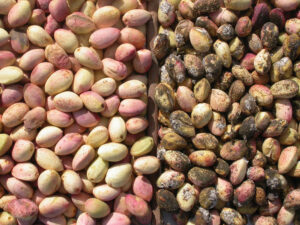
Haviland encourages growers to try new methods on their own, being sure to include an untreated control group for comparison. For example, try both May/June and July sprays on five acres and spray just in May/June on the rest of the acreage. Other treatments to test may include March treatments, releases of predators such as lacewing larvae, or conservation biocontrol that promotes natural enemy populations.
Applying the current best practices and having new ones in the pipeline may help pistachio growers stay ahead of Gill’s mealybug.









